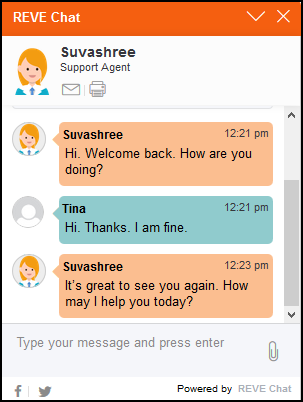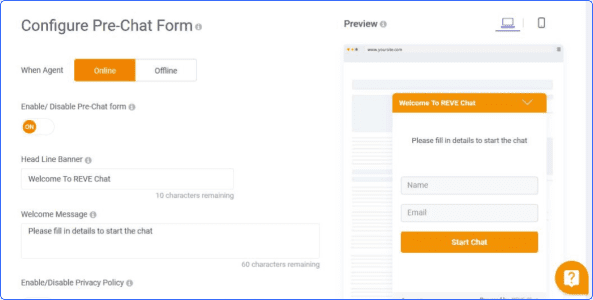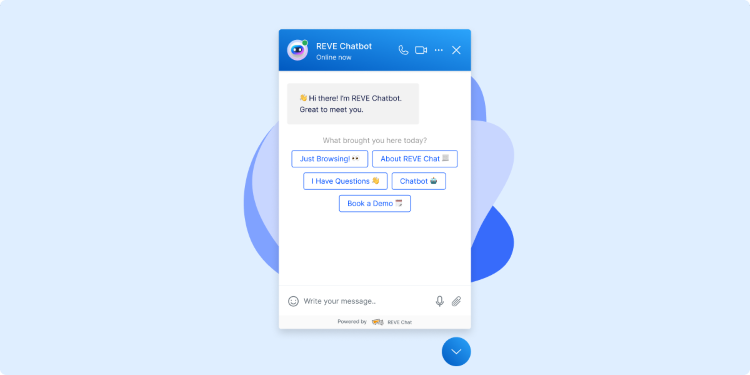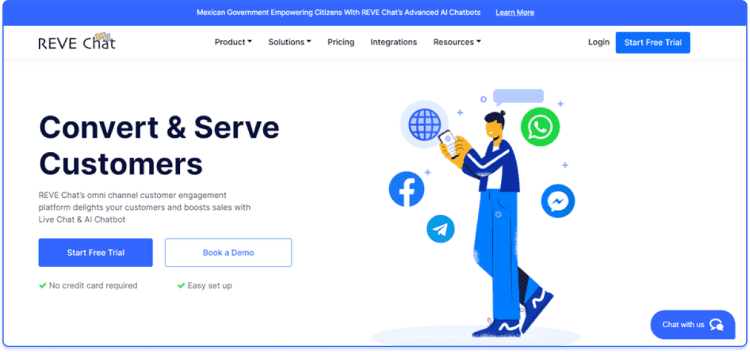Live Chat Window: Best Practices to Follow for Great Experiences
- November 30, 2022
- 13 mins read
- Listen

Table of Content
Let’s start today by giving you a scenario. You have a beautiful website for your business. You care for customers and to offer them the best, you have already implemented email and phone support. But what about those consumers who land on your website daily, go through your offerings, and then just leave silently? Don’t you want them to be your customers? If yes, how to reach them? Through live chat window.
Well, I have the best solution for you. Add a live chat window on your website and proactively engage with them to offer the best customer experience possible. The live chat window can be called the most effective gateway to reach the target audience.
As discussed earlier, you already have two main customer support options-email and telephone. They are good to have. But being a customer, if I want to reach out to you for any assistance, I have to wait. Via phone calls, I have to go through several automated hoops to talk to the support agent.
For email support, first I need to type a long email regarding my queries and then shall wait days and even weeks to get a reply from your side. Trust me, customers do not prefer such long waiting times nowadays. If you don’t upgrade your customer service, chances are high that you will lose them soon.
An effective live chat window can be a savior for you. It allows customers to contact your support team instantly whenever they need any kind of assistance. Also, your team can proactively reach out to them to offer help if required.
Your website works as a vital marketing tool for your company. Adding an effective live chat box there allows you to develop a good connection with your target audience easily. Still not convinced? Let me describe here the different advantages of adding a chat window, useful strategies to make it more effective, and most importantly how to get started.
What is a Live Chat Window?
In simple terms, a chat window is a feature of the live chat software, that offers real-time customer support through a messaging platform. Chat windows may look different depending on company preferences.
You must have seen it. Many times, when you visit a website, there is a chat widget placed may be at the bottom right corner of the website or simply a different pop-up window appears in front of you with a welcome message offering help if required.
You can decide how the chat requests will be handled by your support team, or whether will it be a completely automated process through AI-powered chatbots or both.
The live chat box is an excellent feature to transform your whole customer service and take it to the next level.
Benefits of Adding a Live Chat Window on Your Website
Adding a live chat window on the website allows your customers to reach the support team easily. They can initiate the chat sessions on the same browser itself, which means the customer does not need to download any new software or switch between different apps to connect with your team. A live chat window is not only user-friendly, but it has other benefits too. Let’s look into the followings.
-
Better Customer Engagement
As per Forbes, “50% of consumers say that having a live person answer questions in the middle of a purchasing decision is one of the most important features a brand can offer.”
Engaging with your target audience on the website is crucial. Many times, customers do visit your website, browse through your products and then leave silently. Chat window helps you to engage with them proactively for offering help or just only letting them know about ongoing discounts or new launches.
Effective customer engagement always helps in the decision-making process.
-
Being Proactive Rather Than Reactive
Please don’t wait for the customers to poke you for help. Rather be proactive and engage with them to offer instant assistance regarding anything related to your products, services, or the company.
Many times, customers while browsing your website, may have confusion. Suppose, a customer is looking at your products, but he is confused about the usage or features. Chances are high that he will not be able to make up his mind. Live chat software allows you to monitor your customer’s complete website journey and gives you an idea about the pages he is eyeing. Based on that you can proactively engage with them and offer personalized assistance.
Thus you may help him to make up his mind regarding your product.
-
More Satisfied Customers
You must be dreaming of more satisfied customers. Well, a live chat window is the best way to get in there. As per a recent study by eConsultancy, nearly 73% of customers get satisfied through live chat support, whereas the satisfaction rate for email and phone support is 61% and 44% respectively.
Compared to email and phone support, live chat has become much more preferable to customers because its instant and real-time. Many times. Customers are in hurry and already pissed off with some major issues which need to be addressed as soon as possible. Live chat customer support comes there as a savior to them. So, if you still don’t have it on your website, you are definitely missing something.
-
Improved Sales Conversions
A live chat window not only helps you to offer excellent customer support, but also helps to boost your overall sales conversions.
As per eMarketer, 40% of consumers, who have experienced live chat assistance on the website, are more likely to buy online compared to that 22% of buyers who have never opted for live chat assistance.
Through a live chat window, your support team can directly engage with the consumers and influence their buying decisions, which on other hand, improves sales conversions.
Some Useful Tips to Design an Effective Chat Window for Your Website
Your website visitors can talk to your support team through the chat window. The beauty is it allows you to use all the positive customer interactions for developing a better customer experience.
So, you must work hard to design the chat window more attractive, user-friendly, and engaging. Here, let me give some useful tips to keep in mind while integrating a live chat widget on your website.
-
The Chat Widget Design Should Match the Look and Feel of Your Website
While, integrating the live chat window, always keep in mind that it should match with your brand colour and website design. So, use such colour and design that suits nicely with your website and company logo.
The placement of the chat window is also very important. In the case of an embedded live chat widget, it should be placed in such a place where customers can easily locate it. Generally placing it at the bottom right corner of the website is a very common practice, as it has higher visibility.
-
Personalized Greetings
Live chat lets you monitor your website visitors in real time. You can actually see their page visits, geographic locations, used browsers, and OS. Based on all this information, tell your support team to personalize the greeting messages and reach them proactively.
Your support agents can see the past chat history and it’s a great way to take information about the customer from there and offer more personalized service. With such beautiful initiatives, you can definitely expect better customer satisfaction.
-
Show the Expected Response Time
There are times when your support team needs to handle a large volume of customers. All of them are in a hurry and want instant assistance. Yes, it’s not possible to handle so many of them at a time and respond to their queries promptly. What should they do? Let them know how long they need to wait.
Within the chat window, always mention the customer queue number. If the customers get regular updates regarding the waiting time, most of the time they will happily wait for their turn to come.
You can also mention the expected response time from your side, but be very careful about it as customers may get frustrated if the expected reply time gets changed frequently.
-
Show an Offline Message When You are Not Available
Some companies provide 24/7 customer support and some have operating hours. If you offer the latter, let customers know that your support agents are offline and allow them to send you offline messages.
Once one of your support team members comes online, he can see those offline messages and reply to them directly. There are several ways to do so. You can give the customers a form to fill in their contact details and the message. Later the agents can see those forms and directly reply to them.
Another way is to entirely hide the chat widget so that the consumers cannot contact your support team when they are offline.
No matter what option you are opting for, just inform your customers about the working hours in the chat window itself to avoid any sort of misunderstanding or confusion.
-
Provide Chat Transcripts
A customer who once interacted with your support team may come back to the chat window and look for some information. He may want to see the chat transcripts for any kind of assistance. So, always provide the whole chat history in the chat window itself.
Similarly, your support team also should be able to see the chat history for each and every customer to understand what issues they had resolved, how the whole conversation went, identify the pain points for further improvements, and most importantly personalize a new session with the same customer.
-
Show Voice and Video Call Icons Clearly
Apart from live chat sessions, many times customers also want to initiate voice or video calls directly to your support team. In that case, if you are offering these facilities, please mention them clearly within the chat window itself.
Place the voice and video call icons effectively so that customers can operate them from the same place.
-
Add FAQs Option and Knowledgebase
There are some common queries that customers ask repeatedly. Categorize all those general questions, create some FAQs, knowledgebase, and add the links within the chat window to ease the process.
FAQs help customers to find answers to common queries by themselves only. In case you are using chatbots, configure your bots with all the required information and make sure that it does not sound artificial.
-
Add Short Pre-Chat Forms
A pre-chat form is required when the customer wants to initiate the chat session. When he clicks on the chat widget, the pre-chat form pops up in front of him asking for personal details like name, contact number, email address, type of business, etc. It helps you to get details of customers.
But please don’t ask too many questions because customers may get irritated and chances are high that he will not proceed further. There is a thumb rule for this. Studies show that for each field you add to the pre-chat form, website chat traffic can be reduced to 5-10%. So, it is always recommended to make the form as simple and short as possible.
-
Implement Chatbots When Offline
Many companies cannot afford to provide round-the-clock customer service. Support agents work there in shifts. You may have customers all around the world coming from different geographic locations and time zones. So, how do they get in touch with you after working hours? AI-based chatbots can be at their service.
You can automate the whole customer support process through chatbots when all your support agents are unavailable. Customers can initiate the chat sessions that will be handled by chatbots. They are configured for instant response, enabling you to provide 24/7 customer support.
Difference Between Embedded Chat Window and Pop-Up Chat Window
Live chat widgets can be of two types- embedded and pop up chat windows. Both are available by most of the live chat software providers. Now let’s see the specifications.
Embedded Chat Window
It is placed mostly on the right bottom side of the website. You need to click on the chat button to open the chat window. It has a very neat and clean design and allows the website visitor to see the whole website content without any visual disruption.
The embedded chat window does not affect the overall website performance, as it starts loading content from the server only when a visitor clicks on the live chat button. While chatting with a live chat agent, the customer may minimize the chat window and browse the website with ease. The embedded chat window is very user-friendly and works great on mobile devices too.
Pop-Up Chat Window
It’s an overall separate chat window. When a website visitor wants to initiate a chat, the pop-up chat window makes him switch to a different window. On mobile phones, this kind of chat window opens in a separate tab. This process may seem confusing to many customers.
You may choose any of these based on your requirements and preferences but you need to customize it to match with your website design and brand colour. On the other hand, for an embedded chat window, you need to add JavaScript code, whereas a pop-up chat window runs both from a simple link and JavaScript.
How to Add a Chat Window on Your Website?
Now, you must be thinking that adding a live chat window on your website must be requiring some excellent coding skills, but you are absolutely wrong. Adding live chat software is much simpler. Many companies are now developing live chat software, but setting up process is mostly the same.
You can follow the below-mentioned steps to get started.
- First Sign up for your preferred live chat service and create an account there.
- Next, you need to add the live chat code to the website with a simple HTML code snippet that you will get from the live chat service provider. You can manually integrate the code or install it through plugins.
- Next, you need to customize the chat window to match the look and feel of your website and company brand, preferred language and welcome message.
- Add support agents to your live chat dashboard. Several live chat software companies offer unlimited agent access based on the package you have chosen.
And there you are. Your live chat widget is installed. It’s that simple.
REVE Chat, a Useful Live Chat Software for Your Online Business
REVE Chat is a live chat software that lets website visitors initiate live chat, voice, and video chat with the support team for getting instant assistance. On the other hand, through proactive chat, support agents also can reach out to customers for offering help before they even ask for it.
REVE Chat’s live chat window is completely customizable keeping your brand and website design in mind. With REVE Chat, you can create a customized chat window that includes your company logo, theme, header style, font, and colour of your choice.
REVE Chat’s most powerful features include proactive chat, co-browsing, screen sharing, voice, and video chat, canned responses, chat triggers, department management, analytics, and reporting. REVE Chat also offers AI-based chatbots to automate your whole customer support process.
You can easily add REVE Chat on your website and also supports most CRMs and third-party apps. You can also provide support on the go from your Android and iOS mobile phones. Want to give it a try? SIGN UP today for your 14 days free trial.








